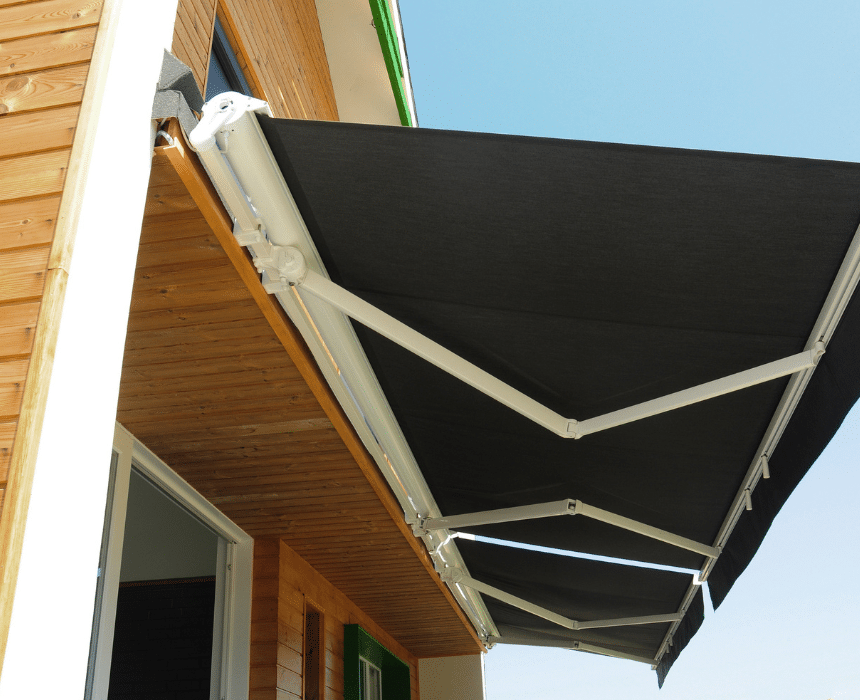Folding arm awnings are an invaluable addition to any home or business, providing shade from the sun, reducing energy costs, and adding aesthetic appeal. But their role extends beyond just these benefits. One of the main reasons people install awnings is for protection against harsh weather conditions, including heavy rain and storms. But how do these structures stand up to such severe weather? Let’s take a closer look.
Folding arm awnings vs. Heavy Rain
Heavy rain can cause considerable damage to your property. However, Folding arm awnings effectively handle heavy rainfall in several ways:
Material and Design
The choice of material and the design of the awning significantly contribute to its ability to withstand heavy rain. Canvas and polyester awnings are often treated with waterproof coatings to repel water. On the other hand, aluminium awnings, due to their natural characteristics, offer excellent water resistance.
Moreover, the design of the awning plays a crucial role in managing heavy rain. Most folding arm awnings have a sloping design that allows water to run off, preventing water pooling that could lead to damage or potential collapse.
Proper Installation
The correct installation of an awning is vital in ensuring its effectiveness against heavy rain. A properly installed awning should have a secure attachment to the building and a sufficient slope to facilitate water drainage. It should also extend far enough to protect against wind-driven rain.

Folding Arm Awnings vs. Storms
Folding arm awnings are not just capable of handling heavy rain; they can also stand up to stormy weather conditions:
Wind Resistance
Folding arm awnings, particularly retractable ones, are designed to resist a certain degree of wind force. This is made possible through their robust construction and materials. However, in cases of extremely high winds or storms, it’s advisable to retract the awning to prevent damage.
Protection Against Debris
During storms, flying debris can cause significant damage to your property. Folding arm awnings can serve as an additional layer of protection, shielding your windows and doors from potential harm.
Maintaining Your Awning’s Durability
To maximise the ability of your awning to handle heavy rain and storms, consider these tips:
Regular Maintenance: Cleaning your awning regularly prevents dirt and debris accumulation, which can weaken its structure over time. Look out for signs of wear and tear and address them promptly.
Retract When Necessary: If you have a retractable awning, ensure to retract it during severe weather conditions to avoid potential damage.
Professional Installation: Having your awning professionally installed makes sure it’s securely attached and positioned correctly for maximum effectiveness.
Quality Materials: Choosing high-quality materials may require a larger investment upfront, but it ensures durability and better weather resistance in the long run.

In conclusion, folding arm awnings are more than just a design addition; they serve a crucial role in protecting your space from heavy rain and storms. By choosing the right material and design, ensuring proper installation, and maintaining regular upkeep, your awning can provide effective weather protection, offering you peace of mind regardless of the weather conditions. Contact our team today!
Summary of Key Points
- Folding arm awnings are beneficial for homes and businesses, providing shade, reducing energy costs, and enhancing aesthetics. They also offer protection against harsh weather conditions like heavy rain and storms.
- The material and design of folding arm awnings contribute significantly to their ability to handle heavy rain. Canvas and polyester awnings often have waterproof coatings, while aluminium awnings naturally resist water. A sloping design prevents water pooling and damage.
- Proper installation is crucial for an awning’s effectiveness against heavy rain. It should be securely attached to the building, have a sufficient slope for drainage, and extend far enough to protect against wind-driven rain.
- Folding arm awnings can withstand stormy weather through their wind resistance and protection against flying debris. They are designed to resist a certain degree of wind force, but should be retracted in extreme conditions.
- Regular maintenance, retracting when necessary, professional installation, and choosing quality materials are key to maximising an awning’s durability and weather resistance.
- Folding arm awnings play a crucial role in protecting spaces from heavy rain and storms. With the right choices and upkeep, they can provide effective weather protection.

0 Comments